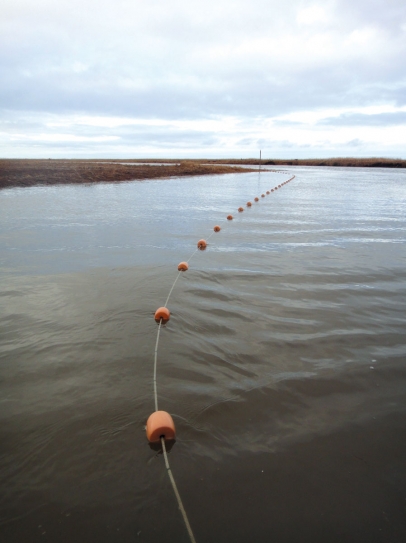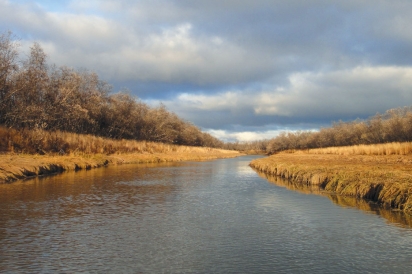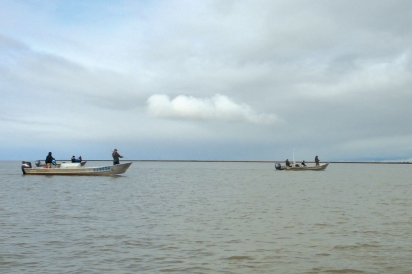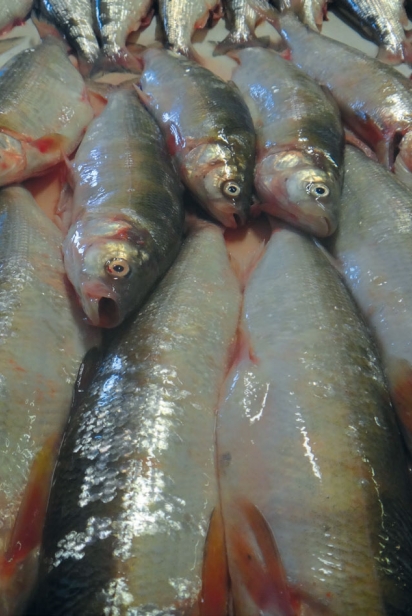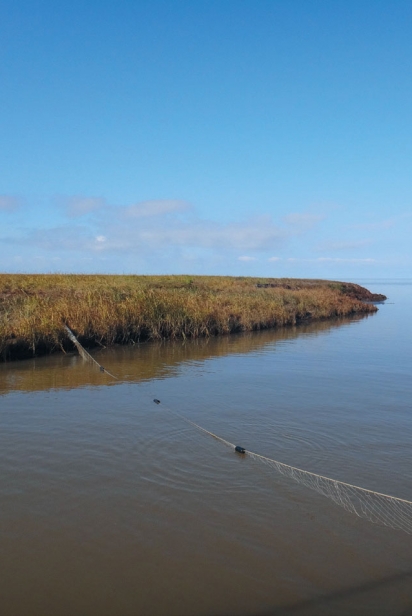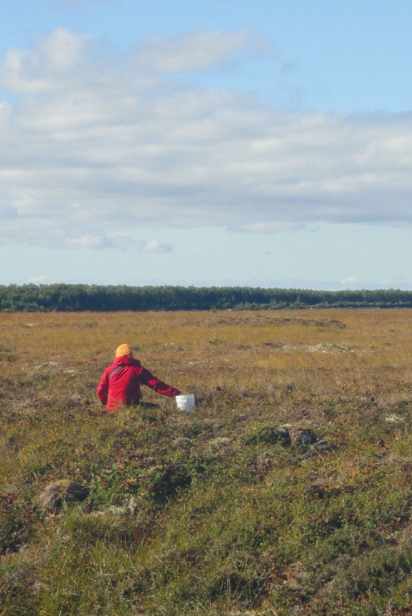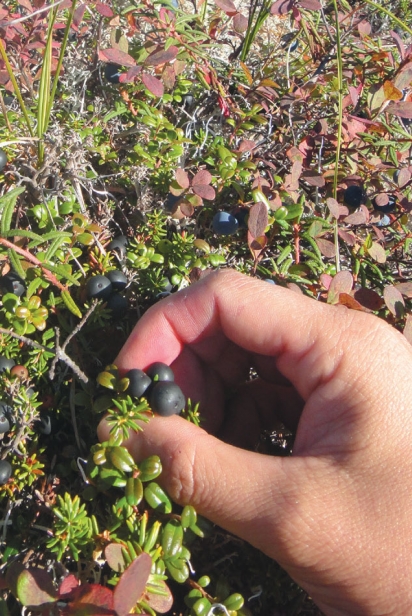Snapshots: Seasons of Subsistence
The Fall Foodscape on the Lower Yukon River
“When the good Lord created the world, he only made one mistake,” declared Billy Charles, as he landed his boat at the edge of a grassy slough. “He left a piece of heaven right here.” Migrating birds called out overhead, flying in formation over the golden tundra. This slough is one of hundreds of gleaming ribbons winding through the marshy wilderness at the mouth of the Yukon River. Further downriver, all waterways end at the Bering Sea.
Billy Charles is a fisherman and community member of Emmonak. At any time of year he and his family can be found outdoors, harvesting a great diversity of wild foods. Many people in the region take pride in continuing to live and thrive in their ancestral homeland. “In the tundra, you won’t go hungry,” he said. “Berries and edible plants grow there. Where there is water, you have fish. There are furbearing animals. Everything is right here.”
Shorter days and falling temperatures mark the end of summer and transition to fall. Producers around Alaska put away their fishing gear, clean out their gardens, and prepare for food-related activities in the great indoors. Yet for remote communities in the Yukon Kuskokwim Delta, the change in season welcomes a new flavor mosaic provided by the rich natural abundance of this remote edge of the world.
Spanning an area the size of Oregon, the delta drains both the Yukon and Kuskokwim Rivers, making it one of the largest river delta systems in the world. This region is also the traditional homeland of Alaska Native Yup’ik and Athabascan peoples. Over 50 communities occupy this vast expanse of mountains, tundra, wetlands, and coastal areas. Similar to other regions in rural Alaska, it is one of the few places on earth where people can harvest foods year-round from the land, water, and sky.
The Lower Yukon is well known as the place where summer runs of salmon begin their riverine journey of nearly 2,000 miles from the Bering Sea to Canada. The fish are packed with Omega-3 fats that fuel their upstream passage. Lower numbers of king salmon necessitate that fishermen in Emmonak and surrounding lower Yukon River communities focus their participation in both commercial and subsistence fishing primarily on chum (or keta) salmon. Kwikp’ak Fisheries, a community-based business, operates a processor that employs locals and ships salmon to customers around the globe. As the summer fishing wanes, many workers return to their home communities to be out on the land and water to hunt, fish, gather berries, and to put away foods for their own families to enjoy all winter.
Dipnets, beach seines, and gillnets for commercial and subsistence fishing in the summer get exchanged for set nets to catch lushfish, also known as burbot. Many species of whitefish, such as sheefish, are caught in abundance. As the tundra’s summer green carpet turns golden, residents submerge the wire baskets of handmade fish traps into tundra ponds. They return in a day or so, and, if lucky, bring home bags full of squirming imangaq (blackfish). Emmonak’s name comes from the Yup’ik word for blackfish. These bony fish are plainboiled and enjoyed with seal oil. The sweet soft meat is reminiscent of catfish, and many locals praise it as “poor man’s lobster.”
With a warming climate, moose have followed the westward migration of shrubby vegetation toward the coast. Whereas older Emmonak hunters remember traveling far upriver to hunt moose, today’s generation of hunters find them lounging on nearby sloughs. Moose hunting is added to the list of fall pursuits, along with three species of seal, beluga whale, and migratory birds heading out for the winter. “We really enjoy eating these foods,” says Malora Hunt as she skillfully plucks one of the birds her son Joel brought home. His catch included tundra swan, a crane, Canada goose, and several ducks. “It reminds me of how I learned to take care of food with my mom.”
The secretary at Emmonak School for many years, Hunt balances work with weekend and evening trips out with her family. “These foods are God’s gifts to us, and it’s a celebration of who we are,” she explains. “It’s part of our identity.” She also emphasized the importance of respecting the hunter through careful processing and storage. “Our men spend a lot of time and energy out on the land to bring this food home. It’s important to show our appreciation by cleaning it right away so that it doesn’t go to waste.”
“It’s fun being out on the land, fishing and hunting,” shared Joel Hunt, a community project coordinator from Emmonak. “It brings back lots of memories, sharing food and good times with other people. There are so many stories and memories.” After earning a college degree in biology from the University of Alaska Fairbanks, the thirty-year-old returned to live in Emmonak because of his close connection to the land and his community. “I always feel really humbled when I’m out there in the wilderness,” he reflected. “That’s the environment that our ancestors lived in. No electronics. I get to experience what they experienced. Sometimes I wonder about how they lived and survived. They had to be strong and tough and physically active.”
As a commercial fisherman, hunter, and trapper, Joel sees his involvement in the foodscape as a way to continue their story. “I remember family members who have passed on, remember the things they taught us. We live it and practice it, but with some modifications to make things a little easier for us.”
Younger people like Joel recognize the many health benefits of local wild foods – and of knowing who harvests these foods. “All the stuff you hear nowadays gets you thinking twice about where the storebought food came from, with additives and preservatives,” he remarked. “But we are also lucky today that we have access to other foods we can’t get from the land, like spices and different veggies and fruits.”
In addition to the physical benefits of harvesting nutrient-dense foods close to home and the active lifestyle that accompanies these activities, involvement in the foodscape yields plenty of fresh air and time outdoors. Staying active keeps the mind agile. The social connections formed while harvesting and processing food together contribute to psychological well-being. People pool their resources for boat trips and invite those who may not have equipment to join them. Some share these foods with those who are unable to provide for themselves. Relationships are kindled and strengthened by cycles of generosity and gratitude. The teachings and practical skills used for survival in the wilderness and preparing for winter can be applied to other aspects of life. The rich foodscape of this region contributes to the well-being in these communities as the next generation faces the challenges of an always changing world.
On the tundra, Billy Charles and his family disperse with buckets in hand. This would be one of many trips out to the tundra to look for berries. The boys carry rifles, just in case they spot birds or moose. The crush of ayuq (Labrador tea), fills the air with the familiar smell in this tundra microclimate of sphagnum moss and lichen. Crowberries gleam like black pearls. Shiny heaps of marble-sized lingonberries spill out over a mat of bright green leaves. The wind and the tumble of berries in buckets are the only sounds as each berry picker dissolves into their own moving tundra meditation.
Sometime in the late afternoon, Billy checks on a set net he tossed across the slough. He pulls up a smattering of gleaming silvery white imarpinraq (Bering cisco). The berry pickers return to the beach at the water’s edge to wrap these delectably oily fish in foil and barbecue them over a fire. The smells of roasted fish mingled with the fragrance of tundra tea signal a fine feast after a day out together. The setting sun casts a copper glow over the tundra as the silver waters of the Yukon continue a timeless flow towards the sea.


